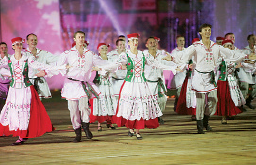 September of decades and centuries past comes to life
September of decades and centuries past comes to lifeSeptember 19th. In 1934, Gennady Golubovich — a Belarusian graphical artist and Honoured Figure of Culture of Belarus — was born in the village of Vileshino, of the Kopyl District.
September 20th. In 1933, a scientist-economist, a Doctor of Economic Sciences and a Professor — Zoya Yuk — was born. She founded the Belarusian Scientific-Research Centre of Gender Problems, becoming its Director.
September 21st. In 1958, a popular composer — Oleg Yeliseenkov — was born. He works in different genres, composing symphonies for a string orchestra and cembalo music. He also composes music on verses by Belarusian and other poets and music for drama performances and films.
September 22nd. In 1969, Valery Tsilent was born in Lida. He was a Greco-Roman wrestler and an honoured master of sports. At the 26th Olympics, Valery took bronze.
September 23rd. In 1914, Ivan Dmukhailo was born — a Belarusian painter and an Honoured Figure of Arts of Belarus.
September 24th. In 1949, a Belarusian surgeon, a Doctor of Medical Sciences and a Professor — Vladimir Anichkin — was born.
September 25th. In 1939, a singer, People’s Artiste of Belarus and USSR — Svetlana Danilyuk — was born.
September 19th. In 1768, Vitebsk’s Chronicles was completed — becoming a Polish-language monument of the 18th century Belarusian city. Written by S. Averka, it is now kept at the Russian National Library (St. Petersburg).
September 19th. In 1883, a glass plant was set up in Berezovka, of the Lida District. During the Great Patriotic War, it was ruined and, in 1944, was restored as the Neman Glassworks.
September 19th. In 1952, the first trolley bus line was launched.
September 19th. In 1991, the Belarusian Soviet Socialistic Republic was re-named into the Republic of Belarus.
September 19th. In 2003, presidents of Belarus, Russia, Ukraine and Kazakhstan signed an agreement and a concept on the establishment of a Single Economic Space in Yalta.
September 20th. In 1945, the Yanka Kupala State Literary Museum opened in Minsk.
September 20th. In 1997, Gomel hosted the 1st International Festival of Choreographic Art: Sozhsky Karagod.
September 21st. In 1952, a monument to Iosif Stalin solemnly opened in Minsk’s Tsentralnaya (now known as Oktyabrskaya) Square, gathering crowds of people.
September 21st. In 1977, Minsk hosted the first all-USSR Fighting Championship (classical and free fighting, as well of sambo).
September 21st. In 1998, a new radio station was launched: Stolitsa (of the Belarusian TV and Radio Company) — becoming the first state-run FM-range station.
September 22nd. In 1785, Minsk’s Higher Seminary opened in Slutsk.
September 22nd. In 1944, the Republican Radio Station began its work.
September 22nd. In 1972, the Kolas Reserve was established in the Minsk Region’s Stolbtsy District. The area includes the village of Nikolaevshchina, Duby settlement and Lastok and Albut mansions.
September 22nd. In 2005, a decision was made to set up the High-Tech Park (at Belarus’ National Academy of Sciences).
September 23rd. In 1994, the Ministry for Emergency Situations and Citizens’ Protection against Chernobyl Disaster was founded. Since 1997, it’s known as the Emergency Ministry.
September 24th. In 1980, a memorial plaque to the USSR Hero — Vladimir Omelyanyuk — was unveiled in Lenin Square, near the Red Roman Catholic Church.
September 25th. In 1897, the first college for the blind opened in Minsk. In 1924, the Belarusian Society of the Blind — now known as BelTIZ — was founded on its basis.
September 25th. In 1906, a head stone was consecrated on the site of the future St. Simeon and Helena Roman Catholic Church.
September 25th. In 1971, the Brest Fortress-Hero Memorial Complex opened to honour the fortress defenders.











